Entry Database : PDB / ID : 3uctTitle Structure of Mn2+-bound N-terminal domain of calmodulin in the presence of Zn2+ Calmodulin Keywords / / / Function / homology Function Domain/homology Component
/ / / / / / / / / / / / / / / / / / / / / / / / / / / / / / / / / / / / / / / / / / / / / / / / / / / / / / / / / / / / / / / / / / / / / / / / / / / / / / / / / / / / / / / / / / / / / / / / / / / / / / / / / / / / / / / / / / / Biological species Homo sapiens (human)Method / / / Resolution : 1.9 Å Authors Senguen, F.T. / Grabarek, Z. Journal : Biochemistry / Year : 2012Title : X-ray Structures of Magnesium and Manganese Complexes with the N-Terminal Domain of Calmodulin: Insights into the Mechanism and Specificity of Metal Ion Binding to an EF-Hand.Authors : Senguen, F.T. / Grabarek, Z. History Deposition Oct 27, 2011 Deposition site / Processing site Revision 1.0 Aug 8, 2012 Provider / Type Revision 1.1 Oct 3, 2012 Group Revision 1.2 Feb 28, 2024 Group / Database references / Derived calculationsCategory chem_comp_atom / chem_comp_bond ... chem_comp_atom / chem_comp_bond / database_2 / pdbx_struct_conn_angle / struct_conn / struct_site Item _database_2.pdbx_DOI / _database_2.pdbx_database_accession ... _database_2.pdbx_DOI / _database_2.pdbx_database_accession / _pdbx_struct_conn_angle.ptnr1_auth_asym_id / _pdbx_struct_conn_angle.ptnr1_auth_comp_id / _pdbx_struct_conn_angle.ptnr1_auth_seq_id / _pdbx_struct_conn_angle.ptnr1_label_asym_id / _pdbx_struct_conn_angle.ptnr1_label_atom_id / _pdbx_struct_conn_angle.ptnr1_label_comp_id / _pdbx_struct_conn_angle.ptnr1_label_seq_id / _pdbx_struct_conn_angle.ptnr2_auth_asym_id / _pdbx_struct_conn_angle.ptnr2_auth_comp_id / _pdbx_struct_conn_angle.ptnr2_auth_seq_id / _pdbx_struct_conn_angle.ptnr2_label_asym_id / _pdbx_struct_conn_angle.ptnr2_label_atom_id / _pdbx_struct_conn_angle.ptnr2_label_comp_id / _pdbx_struct_conn_angle.ptnr3_auth_asym_id / _pdbx_struct_conn_angle.ptnr3_auth_comp_id / _pdbx_struct_conn_angle.ptnr3_auth_seq_id / _pdbx_struct_conn_angle.ptnr3_label_asym_id / _pdbx_struct_conn_angle.ptnr3_label_atom_id / _pdbx_struct_conn_angle.ptnr3_label_comp_id / _pdbx_struct_conn_angle.ptnr3_label_seq_id / _pdbx_struct_conn_angle.value / _struct_conn.pdbx_dist_value / _struct_conn.ptnr1_auth_asym_id / _struct_conn.ptnr1_auth_comp_id / _struct_conn.ptnr1_auth_seq_id / _struct_conn.ptnr1_label_asym_id / _struct_conn.ptnr1_label_atom_id / _struct_conn.ptnr1_label_comp_id / _struct_conn.ptnr1_label_seq_id / _struct_conn.ptnr2_auth_asym_id / _struct_conn.ptnr2_auth_comp_id / _struct_conn.ptnr2_auth_seq_id / _struct_conn.ptnr2_label_asym_id / _struct_conn.ptnr2_label_atom_id / _struct_conn.ptnr2_label_comp_id / _struct_site.pdbx_auth_asym_id / _struct_site.pdbx_auth_comp_id / _struct_site.pdbx_auth_seq_id
Show all Show less
 Yorodumi
Yorodumi Open data
Open data Basic information
Basic information Components
Components Keywords
Keywords Function and homology information
Function and homology information Homo sapiens (human)
Homo sapiens (human) X-RAY DIFFRACTION /
X-RAY DIFFRACTION /  SYNCHROTRON /
SYNCHROTRON /  SAD / Resolution: 1.9 Å
SAD / Resolution: 1.9 Å  Authors
Authors Citation
Citation Journal: Biochemistry / Year: 2012
Journal: Biochemistry / Year: 2012 Structure visualization
Structure visualization Molmil
Molmil Jmol/JSmol
Jmol/JSmol Downloads & links
Downloads & links Download
Download 3uct.cif.gz
3uct.cif.gz PDBx/mmCIF format
PDBx/mmCIF format pdb3uct.ent.gz
pdb3uct.ent.gz PDB format
PDB format 3uct.json.gz
3uct.json.gz PDBx/mmJSON format
PDBx/mmJSON format Other downloads
Other downloads 3uct_validation.pdf.gz
3uct_validation.pdf.gz wwPDB validaton report
wwPDB validaton report 3uct_full_validation.pdf.gz
3uct_full_validation.pdf.gz 3uct_validation.xml.gz
3uct_validation.xml.gz 3uct_validation.cif.gz
3uct_validation.cif.gz https://data.pdbj.org/pub/pdb/validation_reports/uc/3uct
https://data.pdbj.org/pub/pdb/validation_reports/uc/3uct ftp://data.pdbj.org/pub/pdb/validation_reports/uc/3uct
ftp://data.pdbj.org/pub/pdb/validation_reports/uc/3uct Links
Links Assembly
Assembly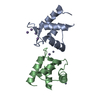

 Components
Components Homo sapiens (human)
Homo sapiens (human)
 X-RAY DIFFRACTION / Number of used crystals: 1
X-RAY DIFFRACTION / Number of used crystals: 1  Sample preparation
Sample preparation SYNCHROTRON / Site:
SYNCHROTRON / Site:  NSLS
NSLS  / Beamline: X29A / Wavelength: 1.758700, 1.075000
/ Beamline: X29A / Wavelength: 1.758700, 1.075000 SAD
SAD Processing
Processing SAD / Resolution: 1.9→36.234 Å / Occupancy max: 1 / Occupancy min: 0.23 / SU ML: 0.49 / σ(F): 1.94 / Phase error: 25.35 / Stereochemistry target values: ML
SAD / Resolution: 1.9→36.234 Å / Occupancy max: 1 / Occupancy min: 0.23 / SU ML: 0.49 / σ(F): 1.94 / Phase error: 25.35 / Stereochemistry target values: ML Movie
Movie Controller
Controller


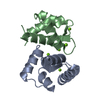
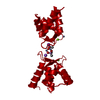
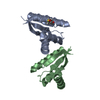
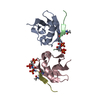
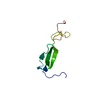

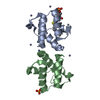



 PDBj
PDBj

























